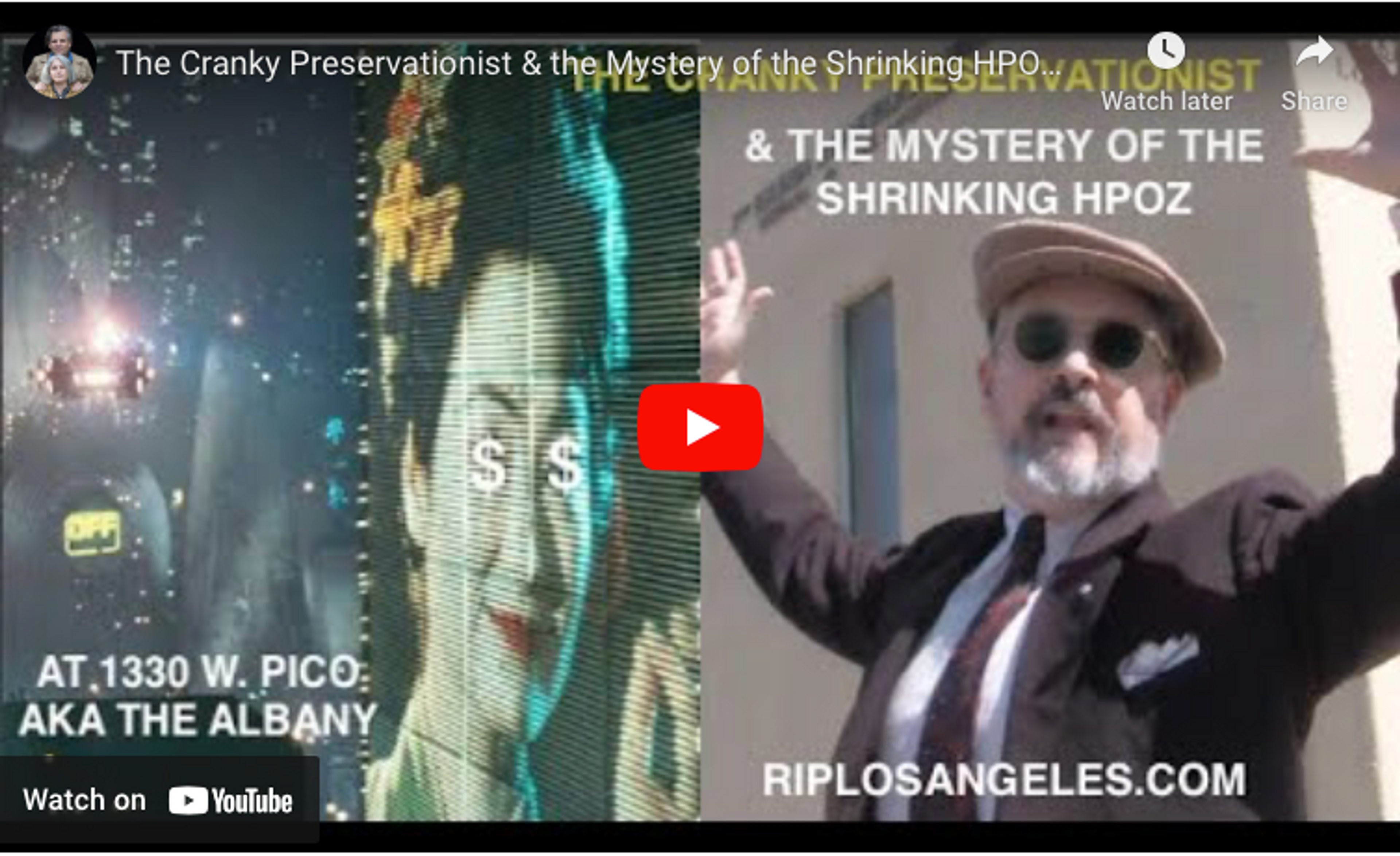Architectural historian Nathan Marsak loves Los Angeles, and hates to see important buildings neglected and abused, whether by slumlord owners or the savage public. Follow him on his urban adventures as he sees something that looks like crap, opens his yap and spontaneously lets you know exactly why this place matters.
Episode 24 finds Nathan on the eastern edge of the Pico-Union Historic Preservation Overlay Zone (HPOZ), a charming, low-slung early 20th century neighborhood of craftsman bungalows, apartment houses, churches and mortuaries that feels a world away from the Convention Center on the other side of the 110 Freeway.
But there’s big trouble brewing on this little block, all wrapped up in a land use mystery that’s had L.A.‘s preservation community scratching its collective head.
HPOZs are supposed to be protected, with historic buildings preserved and the rare new construction respecting what’s already there. So why did Gil Cedillo, the councilman who represents this impoverished district, file a motion carving a warehouse out of the HPOZ, upzoning it for high-rise hotel use? And how did zillionaire developer Eri Kroh of Sandstone
Properties anticipate that the zoning would change when he spent $42 Million to aquire the property?
It just didn’t make sense.
But that was before public records activist Adrian Riskin of the Michael Kohlhaas blog“ got interested. He recently obtained emails from Gil Cedillo’s office that reveal exactly how Sandstone hit the real estate jackpot.
The infuriating answer is that Gil Cedillo’s staff worked overtime to look after the developer, even when it meant telling the Mayor’s office to back off on discussions about turning the warehouse into much-needed homeless housing. The talking points that planning director Gerald Gubatan used when encouraging “the zealot” Ken Bernstein at City Planning to break up the HPOZ were written by Sandstone’s lobbyists. So were the City Council motions submitted by Gil Cedillo. All Cedillo had to do was whip out a pen and sign his name, and a neighborhood’s doom was sealed.
Anyone who cares about the wretched state of our beloved Los Angeles, the demolitions and tent encampments, the illegal Airbnb listings and unaffordable rents, the squandered Measure HHH housing funds, the filth and the cruelty, should read the blog post describing these emails, and possibly the emails as well.
To get a taste of how special this block is, and why it’s entirely unsuitable for the enormous tower and sign district requested by Sandstone’s lobbyists and provided by their friendly councilman, let the Cranky Preservationist take you on a tour. You’ll see beauty, surprises, sorrow and a very special slice of sidewalk along the way.
Open your eyes, friends! Terrible people are bleeding Los Angeles dry with their Sacramento-style policy savvy and lack of compassion, and some of them will retire with government pensions. They’re destroying our neighborhoods and shortening our neighbors’ lives.
But we don’t have to settle for this twisted lack of representation. The only question is how much longer will YOU stand for it?
If you like these Cranky Preservationist videos, you’ll probably like Nathan’s R.I.P. Los Angeles blog, too, so check it out!
Where will the Cranky Preservationist turn up next? Stay tuned!
About Nathan Marsak
NATHAN MARSAK says: “I came to praise Los Angeles, not to bury her. And yet developers, City Hall and social reformers work in concert to effect wholesale demolition, removing the human scale of my town, tossing its charm into a landfill. The least I can do is memorialize in real time those places worth noting, as they slide inexorably into memory. In college I studied under Banham. I learned to love Los Angeles via Reyner’s teachings (and came to abjure Mike Davis and his lurid, fanciful, laughably-researched assertions). In grad school I focused on visionary urbanism and technological utopianism—so while some may find the premise of preserving communities so much ill-considered reactionary twaddle, at least I have a background in the other side. Anyway, I moved to Los Angeles, and began to document. I drove about shooting neon signs. I put endless miles across the Plains of Id on the old Packard as part of the 1947project; when Kim Cooper blogged about some bad lunch meat in Compton, I drove down to there to check on the scene of the crime (never via freeway—you can’t really learn Los Angeles unless you study her from the surface streets). But in short order one landmark after another disappeared. Few demolitions are as contentious or high profile as the Ambassador or Parker Center; rather, it is all the little houses and commercial buildings the social engineers are desperate to destroy in the name of the Greater Good. The fabric of our city is woven together by communities and neighborhoods who no longer have a say in their zoning or planning so it’s important to shine a light on these vanishing treasures, now, before the remarkable character of our city is wiped away like a stain from a countertop. (But Nathan, you say, it’s just this one house—no, it isn’t. Principiis obsta, finem respice.) And who knows, one might even be saved. Excelsior!””
Nathan’s blogs are: Bunker Hill Los Angeles, RIP Los Angeles & On Bunker Hill.
